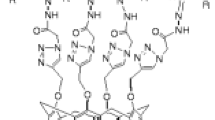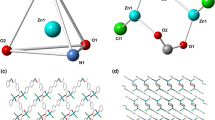Abstract
By introducing 1,2,3-triazole-ester groups on thiacalix[4]arene based on click chemistry and then ammonolysis with ethylenediamine, diethylenetriamine or triethylenetetramine, three novel 1,2,3-triazole-modified thiacalix[4]arene polymers were conveniently prepared in “4+2” condensation mode in ideal yields. The structures of polymers 4a–4c were confirmed by elemental analysis, FTIR and 1H NMR spectra. The surface morphologies of polymers 4a–4c were investigated by SEM micrographs. The M n of novel polymers 4a–4c indicated approximately 18–20 calixarene units in each polymer molecule. The dye adsorption abilities of polymers 4a–4c for series of organic dyes (alizarin green, orange I, neutral red (NR), Congo red (CR), orange G (OG), crystal violet, Victoria blue B and methylene blue) were studied by solid–liquid adsorption experiments. The adsorption experimental results implied that they had excellent adsorption abilities for tested organic dyes. The highest adsorption percentage reached 97 % for OG. The best saturation adsorption capacities for NR and CR were as high as 1.282 and 1.407 mmol/g, respectively. These novel polymers possessed stable adsorption abilities in the scopes of pH 5–9 and had good reused properties after desorption. The adsorption mechanism proposed that not only dipole interaction, electrostatic interaction and hydrogen bonding interaction, but also the π–π stacking interaction plays important role in binding dyes.






Similar content being viewed by others
References
Wong Y, Yu J (1999) Laccase-catalyzed decolorization of synthetic dyes. Water Res 33:3512–3519
Crini G (2005) Recent developments in polysaccharide-based materials used as adsorbents in wastewater treatment. Prog Polym Sci 30:38–70
Peternel IT, Koprivanac N, Bozic AML, Kusic HM (2007) Comparative study of UV/TiO2, UV/ZnO and photo-Fenton processes for the organic reactive dye degradation in aqueous solution. J Hazard Mater 148:477–484
Crini G, Badot PM (2008) Application of chitosan, a natural aminopolysaccharide, for dye removal from aqueous solutions by adsorption processes using bath studies: a review of recent literature. Prog Polym Sci 33:399–447
Mahdavinia GR, Iravani S, Zoroufi S, Hosseinzadeh H (2014) Magnetic and K+-cross-linked kappa-carrageenan nanocomposite beads and adsorption of crystal violet. Iran Polym J 23:335–344
Barikani M, Oliaei E, Seddiqi H, Honarkar H (2014) Preparation and application of chitin and its derivatives: a review. Iran Polym J 23:307–326
Chakraborty S, Purkait MK, Das Gupta S, De S, Basu JK (2003) Nanofiltration of textile plant effluent for color removal and reduction in COD. Sep Purif Technol 31:141–151
Ghosh D, Bhattacharyya KG (2002) Adsorption of metheylene blue on kaolinite. Appl Clay Sci 20:295–300
Akceylan E, Bahadir M, Yilmaz M (2009) Removal efficiency of a calix[4]arene-based polymer for water-soluble carcinogenic direct azo dyes and aromatic amines. J Hazard Mater 162:960–966
Ozmen EY, Sirit A, Yilmaz M (2007) A calix[4]arene oligomer and two betacyclodextrin polymers: synthesis and sorption studies of azo dyes. J Macromol Sci Pure 44:167–173
Yilmaz A, Yilmaz E, Yilmaz M, Bartsch RA (2007) Removal of azo dyes from aqueous solutions using calix[4]arene and cyclodextrin. Dyes Pigment 74:54–59
Kamboh MA, Solangi IB, Sherazi STH, Memon S (2011) A highly efficient calix[4]arene based resin for the removal of azo dyes. Desalination 268:83–89
Kamboh MA, Solangi IB, Sherazi STH, Memon S (2011) Synthesis and application of p-tert-butylcalix[8]arene immobilized material for the removal of azo dyes. J Hazard Mater 186:651–656
Chen M, Shang T, Fang W, Diao G (2011) Study on adsorption and desorption properties of the starch grafted p-tert-butyl-calix[n]arene for butyl Rhodamine B solution. J Hazard Mater 185:914–920
Guo HY, Yang FF, Chai XF, Jiao ZY, Li CC (2012) Synthesis of novel calix[6]-1,4-crown-based netty polymer and its excellent adsorption capabilities for aniline derivatives. Iran Polym J 21:451–456
Yang FF, Huang ZS, Zhang XY, Guo HY (2010) Thiacalix[4]amido-based netty polymers: novel sorbents for heavy metal cations and derivatives of aniline. Iran Polym J 19:309–318
Yang FF, Liu WW, Xie JW, Bai XY, Guo HY (2013) Novel deep-cavity calix[4]arene derivatives with s-triazine conjugate systems: synthesis and complexation for dyes. J Incl Phenom Macrocycl Chem 76:311–316
Yang FF, Zhang YM, Guo HY, Wei XL (2013) Highly efficient liquid membrane transport of dyes using calix[4]arene-linked triphenylene dimers as carriers. Sep Sci Technol 48:1565–1571
Bai XY, Yang FF, Xie JW, Guo HY (2013) Novel 1,2-3,4-bridged and 1,3-bridged calix[4]arene based on large s-triazine conjugate systems: synthesis and complexation for dyes. J Macromol Sci Pure 50:334–339
Kumar M, Bhalla V, Dhir A, Babu JN (2010) A Ni2+ selective chemosensor based on partial cone conformation of calix[4]arene. Dalton Trans 39:10116–10121
Coquiere D, LeGac S, Darbost U, Seneque O, Jabin I, Reinaud O (2009) Biomimetic and self-assembled calix[6]arene-based receptors for neutral molecules. Org Biomol Chem 7:2485–2500
Kovalev VV, Khomich EV, Shokova EA, Babain AV, Alyapyshev MY (2008) Synerg istic extraction of cesium, strontium, and europium with adamanty lated thiacalix[4]arenes in the presence of chlorinated cobalt dicarbollide. Russ J Gen Chem 78:19–25
Feng NM, Zhao HY, Zhan JY, Tian D, Li H (2012) Switchable wettability sensor for ion pairs based on calix[4]azacrown clicking. Org Lett 14:1958–1961
Zhan JY, Fang F, Tian DM, Li HB (2012) Anthraquinone-modified calix[4]arene: click synthesis, selective calcium ion fluorescent chemosensor and INHIBIT logic gate. Supramol Chem 24:272–278
Hardman MJ, Thomas AM, Carroll LT, Williams LC, Parkin S, Fantini JL (2011) Synthesis and ‘click’ cycloaddition reactions of tetramethoxy- and tetrapropoxy-2-(omega-azidoalkyl)calix[4]arenes. Tetrahedron 67:7027–7034
Guo HY, Yang FF, Jiao ZY, Lin JR (2013) Click synthesis and dyes extraction capabilities of novel thiacalix[4]arene derivatives with triazole groups and hydrogen bond groups. Chin Chem Lett 24:450–452
Iki N, Kumakai H, Morohashi N, Ejima K, Hasegawa M, Miyanri S, Miyano S (1998) Selective oxidation of thiacalix[4]arenes to the sulfinyl- and sulfonylcalix[4]arenes and their coordination ability to metal ions. Tetrahedron Lett 39:7559–7562
Yang FF, Bai XY, Xu BT, Guo HY (2013) Triphenylene-modified chitosan: novel high efficient sorbent for cationic and anionic dyes. Cellulose 20:895–906
Xie K, Zhao W, He X (2011) Adsorption properties of nano-cellulose hybrid containing polyhedral oligomeric silsesquioxane and removal of reactive dyes from aqueous solution. Carbohydr Polym 83:1516–1520
Duan C, Zhao N, Yu X, Zhang X, Xu J (2013) Chemically modified kapok fiber for fast adsorption of Pb2+, Cd2+, Cu2+ from aqueous solution. Cellulose 20:849–860
Mao Y, Guan Y, Zheng Q, Feng X, Wang X (2011) Adsorption thermodynamic and kinetic of disperse dye on cotton fiber modified with tolylene diisocyanate derivative. Cellulose 18:271–279
Acknowledgments
Financial support from the National Natural Science Foundation of China (No: 21406036), Fujian Natural Science Foundation of China (No. 2014J01034), Project of Fujian Provincial Department of Education (JA11044, JA10056, JB13011) and the Program for Innovative Research Team in Science and Technology in Fujian Province University were greatly acknowledged.
Author information
Authors and Affiliations
Corresponding author
Rights and permissions
About this article
Cite this article
Lai, J., Yang, F., Guo, H. et al. Novel effective dye sorbents: synthesis and properties of 1,2,3-triazole-modified thiacalix[4]arene polymers based on click chemistry. Iran Polym J 23, 899–906 (2014). https://doi.org/10.1007/s13726-014-0289-9
Received:
Accepted:
Published:
Issue Date:
DOI: https://doi.org/10.1007/s13726-014-0289-9




